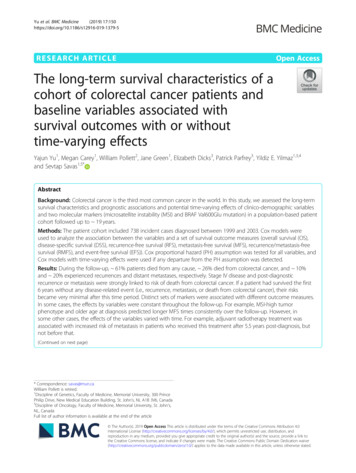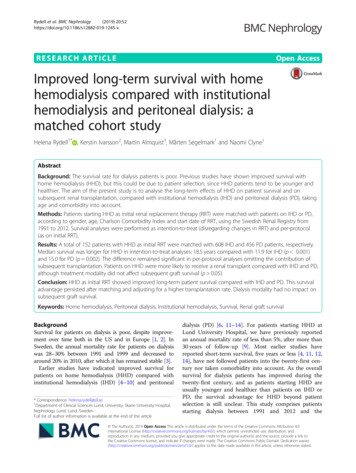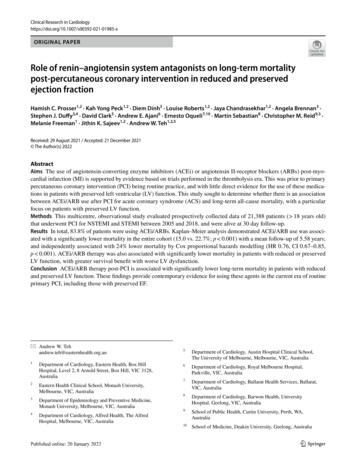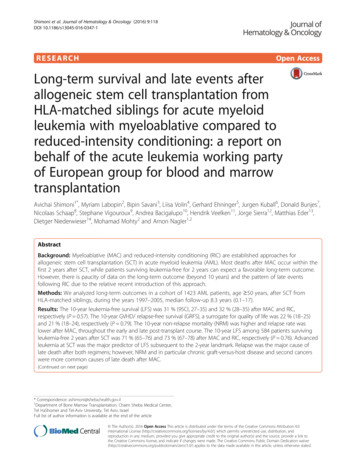
Transcription
Yu et al. BMC Medicine(2019) EARCH ARTICLEOpen AccessThe long-term survival characteristics of acohort of colorectal cancer patients andbaseline variables associated withsurvival outcomes with or withouttime-varying effectsYajun Yu1, Megan Carey1, William Pollett2, Jane Green1, Elizabeth Dicks3, Patrick Parfrey3, Yildiz E. Yilmaz1,3,4and Sevtap Savas1,5*AbstractBackground: Colorectal cancer is the third most common cancer in the world. In this study, we assessed the long-termsurvival characteristics and prognostic associations and potential time-varying effects of clinico-demographic variablesand two molecular markers (microsatellite instability (MSI) and BRAF Val600Glu mutation) in a population-based patientcohort followed up to 19 years.Methods: The patient cohort included 738 incident cases diagnosed between 1999 and 2003. Cox models wereused to analyze the association between the variables and a set of survival outcome measures (overall survival (OS),disease-specific survival (DSS), recurrence-free survival (RFS), metastasis-free survival (MFS), recurrence/metastasis-freesurvival (RMFS), and event-free survival (EFS)). Cox proportional hazard (PH) assumption was tested for all variables, andCox models with time-varying effects were used if any departure from the PH assumption was detected.Results: During the follow-up, 61% patients died from any cause, 26% died from colorectal cancer, and 10%and 20% experienced recurrences and distant metastases, respectively. Stage IV disease and post-diagnosticrecurrence or metastasis were strongly linked to risk of death from colorectal cancer. If a patient had survived the first6 years without any disease-related event (i.e., recurrence, metastasis, or death from colorectal cancer), their risksbecame very minimal after this time period. Distinct sets of markers were associated with different outcome measures.In some cases, the effects by variables were constant throughout the follow-up. For example, MSI-high tumorphenotype and older age at diagnosis predicted longer MFS times consistently over the follow-up. However, insome other cases, the effects of the variables varied with time. For example, adjuvant radiotherapy treatment wasassociated with increased risk of metastasis in patients who received this treatment after 5.5 years post-diagnosis, butnot before that.(Continued on next page)* Correspondence: savas@mun.caWilliam Pollett is retired.1Discipline of Genetics, Faculty of Medicine, Memorial University, 300 PrincePhilip Drive, New Medical Education Building, St. John’s, NL A1B 3V6, Canada5Discipline of Oncology, Faculty of Medicine, Memorial University, St. John’s,NL, CanadaFull list of author information is available at the end of the article The Author(s). 2019 Open Access This article is distributed under the terms of the Creative Commons Attribution 4.0International License (http://creativecommons.org/licenses/by/4.0/), which permits unrestricted use, distribution, andreproduction in any medium, provided you give appropriate credit to the original author(s) and the source, provide a link tothe Creative Commons license, and indicate if changes were made. The Creative Commons Public Domain Dedication o/1.0/) applies to the data made available in this article, unless otherwise stated.
Yu et al. BMC Medicine(2019) 17:150Page 2 of 12(Continued from previous page)Conclusions: This study describes the long-term survival characteristics of a prospective cohort of colorectal cancerpatients, relationships between baseline variables and a detailed set of patient outcomes over a long time, andtime-varying effects of a group of variables. The results presented advance our understanding of the long-termprognostic characteristics in colorectal cancer and are expected to inspire future studies and clinical care strategies.Keywords: BRAF Val600Glu mutation, Colorectal cancer, Cox model with time-varying effects, Early outcome markers,Late outcome markers, Long-term follow-up, MSI, Prognostic markers, Time-varying effectsBackgroundColorectal cancer is an important disease to control. It isone of the most commonly diagnosed cancers in theworld, causing 700,000 deaths each year [1]. Many patients with colorectal cancer also experience clinicallyimportant events, such as recurrences or metastasesafter diagnosis. Assessing the characteristics of potentialdisease outcomes and identifying their predictors arecritical for effective patient surveillance, and to treat andcontrol this disease in both the short term and longterm. Studies have reported that the majority of the recurrences, metastases, and deaths from colorectal canceroccur within the first few years following the diagnosisor surgery [2, 3]. The main clinical surveillance guidelines recommend up to 5 years of follow-up [4].Clinical features (e.g., disease stage, tumor grade,histology, location), demographic variables (e.g., age atdiagnosis, sex, and familial risk status), and tumor characteristics (e.g., the MSI tumor phenotype and somaticmutations, including BRAF Val600Glu mutation) areamong the most commonly investigated variables incolorectal cancer [5–10]. Familial risk status mayindicate familial clustering of the disease and is aninterest for both the susceptibility and prognostic studies[10, 11]. Microsatellite instability (MSI) is a tumorphenotype that is characterized by defects in the DNAmismatch repair system that leads to genomic instability[12]. Generally, MSI-high tumors are associated withbetter patient survival [7]. BRAF Val600Glu mutationoccurs in 10% of the colorectal tumors, causes oncogenic BRAF activity, and promotes cellular transformation [9]. Literature reports also suggest a prognosticrole for this BRAF mutation in colorectal cancer [13].Many prognostic studies aim to identify the markersto help distinguish the patients with different outcomerisks. Potential time-varying effects of markers on thepatient outcomes, however, are not well-studied.Markers with time-varying effects are those whose effectdirection (e.g., protective or detrimental) or size (i.e.,magnitude) changes over the follow-up [14–18]. Thereare at least two important implications of assessing thetime-varying effects of the markers in prognostic studies.First, such markers are important as they can distinguishthe patients who are at increased risk of events onlyduring specific time periods (e.g., in the short term [earlyevent markers] or the long term [late event markers ormarkers with late effects]). Second, examining the timevarying effects of variables is not a standard or widelyutilized research practice, which potentially leads to lossof information or inaccurate inference [14, 19, 20].In colorectal cancer, a few studies examined theclinical, demographic, or molecular variables for timevarying effects using statistical methods. For example,disease location [21]; age, disease stage, time period ofdiagnosis, or tumor site [15, 16, 18]; regional cancer, age,and tumor location (pelvic/sigmoid colon) [22]; age (intwo of our previous studies using subsets of the patientsincluded in this study) [23, 24]; tumor site (left or right),grade, sex, and stage [25]; a set of genetic variations[23, 26]; and a somatic tumor alteration [27] werereported to have or tend to have time-varying effects onpatient outcomes. Among the statistical methods that areused for the identification of time-varying effects are themixture cure model [28], Cox-Aalen model, additivemodels with time-varying effects, and multiplicative modelswith time-varying effects (including piece-wise/changepoint Cox proportional hazards [PH] regression model)[29, 30]. Cox PH regression model [31, 32] is one of themost widely used statistical models for time-to-event analyses in medical sciences [19]. This model has an assumption (the PH assumption) where the hazard ratio for anytwo groups of patients stratified by a variable remains constant over time. Violation of the PH assumption impliesthat the effect of the variable being investigated changesover time [31–33]. Hence, assessing the PH assumption inCox models is an opportunity to identify the variables thathave time-varying effects on patient outcomes.While colorectal cancer is a common disease in theworld, long-term prognostic characteristics and theirpredictors are not well known. In this study, we investigated the data collected from a prospective colorectalcancer patient cohort followed up to 19 years. Our specific aims were to examine (1) the long-term survivalcharacteristics and (2) the associations as well as the potential time-varying effects of the widely investigatedbaseline clinico-demographic variables and select molecular markers on a comprehensive set of patient outcome measures.
Yu et al. BMC Medicine(2019) 17:150Page 3 of 12MethodsTable 1 Baseline characteristics of the patient cohortPatient cohort, patient-related data, and inclusion criteriaVariableThis is an observational study. The patient cohort examined in this study was recruited by the NewfoundlandColorectal Cancer Registry [34, 35]. This registry includes 750 incident cases, who were diagnosed withcolorectal cancer in Newfoundland and Labrador (NL)between January 1999 and December 2003. These patients constituted 64% of the eligible patients who werediagnosed within this time frame. Among the 750 patients recruited by the registry, clinical and prognosticdata of 744 patients were available in the registry andwere provided to the study team. Out of 744, 738colorectal cancer patients with stage I–IV disease andage at diagnosis 75 were included in the present study(5 patients with in situ/stage 0 tumors and 1 patientwith 75 years of age were excluded). In this study, clinical, pathological, demographic, and molecular markersthat are most widely examined by the colorectal cancer research community and present in at least 5% of the patientcohort were selected for assessment (Table 1). TumorMSI and BRAF Val600Glu mutation statuses were determined previously as described in Woods et al. [35], and familial risk status was assessed as described in Green et al.[34]. Information on the clinical, pathological, anddemographic as well as the vital status, cause of death, recurrence, and metastasis was collected over time usingseveral resources as described in Negandhi et al. [36] thatincluded patient follow-up questionnaires, medical records (e.g., physician notes/assessments, pathology, surgery, and autopsy reports/death certificates), ProvincialTumor Registry-NL/Dr. H. Bliss Murphy CancerCentre, and NLCHI (Newfoundland and LabradorCentre for Health Informatics). The distinction between loco-regional recurrence and distant metastasiswas based on the pathology reports, diagnostic imaging reports, location of tumors, or physician’s notes.If a tumor had occurred in the field of the primaryresected tumor, including proximal or distal to thesite of anastomosis, it was classified as recurrence.Distant recurrences were classified as metastasis basedon the location and clinical assessment of the originof the tumor and physicians’ opinions.The last date of follow-up in this cohort was January2018. An overview of the characteristics of the clinicodemographic variables and molecular markers of the patient cohort is shown in Table 1.Age at diagnosisStatistical analysesAssessing the collinearity among the variablesWe assessed and ruled out the potential correlationbetween the categorical variables (Table 1) based onthe pair-wise Pearson’s correlation coefficient value(Additional file 1: Table S1).NumberPercentage (%)62.37 (20.70–75.01)–Male45261.25Female28638.75Low risk35548.10High/intermediate nous64687.54Mucinous9212.4763686.18Median (range)SexFamilial riskLocationStageHistologyMSI F Val600Glu mutation radeWell/moderately differentiatedPoorly differentiated739.89Unknown121.6338752.44Adjuvant chemotherapy treatmentNoYes34646.88Unknown50.6856576.56Adjuvant radiotherapy treatmentNoYes15120.46Unknown222.98MSI microsatellite instability, MSI-H microsatellite instability-high,MSI-L microsatellite instability-low, MSS microsatellite stable
Yu et al. BMC Medicine(2019) 17:150Page 4 of 12Survival outcomesA set of widely investigated survival outcomes wereexamined in order to conduct a comprehensive investigation. The endpoints of overall survival (OS),disease-specific survival (DSS), recurrence-free survival (RFS), metastasis-free survival (MFS), recurrenceor metastasis-free survival (RMFS), and event-freesurvival (EFS) were death from any cause, death fromcolorectal cancer, diagnosis of local recurrence, diagnosis of distant metastasis, diagnosis of recurrence ormetastasis, and diagnosis of recurrence, metastasis,or death from colorectal cancer, respectively. Survivaltimes were calculated starting at the date of diagnosis till the date of the first occurrence/observation ofthe endpoint (or the date of last contact); in multievent outcomes, the latter date was the date of thefirst event. In each survival outcome, data were censored at the date of last contact for patients whohave not experienced the events of interest duringtheir follow-up. Data on the survival outcomes aresummarized in Table 2.Table 2 Number of events in the survival outcomes examinedin this studySurvival statusNumberPercentage (%)Alive29039.30Died44860.70Death from other causes or alive39954.07Death from colorectal cancer19226.02*Unknown14719.92Recurrence ( )66189.57Recurrence ( )7710.43Metastasis ( )58779.54Metastasis ( )15120.46OS statusDSS statusRFS statusMFS statusRMFS statusRecurrence or metastasis ( )54273.44Recurrence or metastasis ( )19626.56Recurrence, metastasis, or death fromcolorectal cancer ( )35948.64Recurrence, metastasis, or death fromcolorectal cancer ( )28737.67*Unknown10113.69EFS statusDSS disease-specific survival, EFS event-free survival, MFS metastasis-freesurvival, OS overall survival, RFS recurrence-free survival, RMFSrecurrence/metastasis-free survival*This is because the cause of death information was missing for some patientsKaplan-Meier and Cox regression analyses and proportionalhazards assumption testIBM SPSS Statistics (version 25) was used for KaplanMeier method that generated the survival curves.Univariate Cox models were fitted for variables for eachof the survival outcomes. PH assumption test [37] wasperformed using cox.zph function [38] in R (ver. 3.5.0)[39] using the default “km” function to obtain the transformed survival times. Multivariate Cox models wereconstructed using backward selection method, and whenthe PH assumption was violated, Cox model with timevarying effects (assuming piece-wise constant hazard ratios—this model is also called change-point Cox model[29, 30]) was used. Full multivariate models with allbaseline variables were first checked for the PH assumption. For the variables that violated the PH assumption,cutoff time points before and after which the PH assumption was satisfied were obtained, starting from thevariable with the lowest p value of the PH assumptiontest. The proper cutoff time points were selected basedon the approach described in Pavelitz et al. [27] andKlein and Moeschberger [29]. In this study, a set of cutoff time points ranging from 0.5 to 18.5 years and withincrements of 0.5 years was considered. The proper cutoff time point is ideally the one which makes the model(1) having the largest maximized log partial likelihoodand (2) with the PH assumptions being satisfied beforeand after the time point. If the model with the largestmaximized log partial likelihood did not satisfy the proportional hazards at both time intervals separated by thetested time point, then the one with the second largestmaximized log partial likelihood value was tested. Thisstep was repeated until a model was obtained that satisfied the criteria. The corresponding cutoff time pointwas then deemed to be the proper cutoff time point. Incases when the cutoff time points made the model having an infinite upper limit of the 95% confidence interval(CI) for hazard ratio (HR) of a variable, the cutoff pointwith the next largest maximized log partial likelihoodwas considered. This is because infinite limits suggestthat a valid effect estimation cannot be made. Inaddition, rarely a proper cutoff time point for a variablewas not identifiable. For example, for stage III in the OSanalysis, a single time point that satisfies the PH assumption in both time periods (before and after the timepoint) was not identified. We then introduced additionaltime points in one of the time periods where the PH assumption was violated. However, this step did not identify any proper time points in this region. In this case,we analyzed this variable with the next one in line (i.e.,the next variable with the smallest p value of the PH assumption test) and tested all the possible combinationsof the cutoff time points to identify the proper cutoffpoints of both variables at the same time. Once the
Yu et al. BMC Medicine(2019) 17:150proper cutoff time points were identified and includedin the model, variables with p values 0.05 in the modelwere removed one by one, starting with the one with thelargest p value. During this process, if any of theremaining variables violated the PH assumption, the cutoff time point was identified/re-identified for this variable based on the method described above, followed byre-fitting of the model. The variables in the final modelfor each outcome measure reported in this manuscripthave a p value 0.05 either over the follow-up time (i.e.,variables with no time-varying effects) or in at least onetime period defined by the cutoff time points (i.e., variables with time-varying effects).Age at diagnosis was examined as a continuous variable in this study. A p value 0.05 was considered significant. All statistical analyses were performed by R(ver. 3.5.0) [39] or IBM SPSS Statistics (version 25).Page 5 of 12Survival patterns over timeKaplan-Meier curves for the outcome measures examined are shown in Fig. 1. Unlike death from all causes(OS: Fig. 1a), the majority (85%) of the deaths due to colorectal cancer occurred within 6.2 years post-diagnosis(DSS: Fig. 1b). Similarly, the majority (85%) of thefirst recurrences and/or metastases were diagnosedwithin 5 years after the disease diagnosis (5.1 years forRFS; 4.9 years for MFS; 4.5 years for RMFS; Fig. 1c-e).As for the EFS that considers the three most importantdisease-related events, 85% of the first of any of theseevents were observed within the first 4.5 years afterdiagnosis (Fig. 1f). It is important to note that within thisgroup of patients (i.e., with a positive status of recurrence,metastasis, or death from colorectal cancer), only a smallportion of the patients (5%) experienced their first disease-related events after 6 years following the diagnosis ofcolorectal cancer.ResultsCharacteristics of the survival outcomes in the patientcohortBaseline characteristics of the patients and information onthe outcome measures investigated are shown in Tables 1and 2. The median follow-up time was 9.36 years and witha range of 0.04 to 19.00 years. Among the 738 colorectalcancer patients, 448 ( 61%) died by the end of the followup period. The number of deaths caused by colorectalcancer (n 192) accounted for 43% of all deaths. StageIV patients had the highest rate of death (death from anycause and death from colorectal cancer were recorded forthe 94.8% and 86.9% of the stage IV patients, respectively).In addition, 77 patients ( 10%) had experienced at leastone local recurrence, and 151 individuals ( 20%) hadexperienced at least one metastasis. The majority ofthe patients diagnosed with recurrence or metastasiswere stage II or III patients, whereas 14% of the patients who experienced recurrences and 7% of thepatients who experienced metastases during their follow-up were stage I patients. Around 27% (n 196) ofthe patients experienced either recurrence or metastasis. The proportion of patients who had experiencedboth recurrence and metastasis was low (n 32 patients; 4%), yet almost half of the patients who hadrecurrence also had metastasis. Approximately 73% ofthe patients who were diagnosed with recurrence ormetastasis died from colorectal cancer (110 out of150 patients with complete data on recurrence, metastasis, and cause of death). Of the 448 patients diedduring the follow-up period, 171 patients experiencedrecurrence or metastasis before they passed away.Overall, 38% of the patients had at least one disease-related and clinically important event (i.e., recurrence, metastasis, or death from colorectal cancer)during the follow-up.Variables with or without time-varying effects on survivaloutcomesUnivariate analysesUnivariate associations between clinico-demographicand molecular variables and survival outcomes are summarized in Fig. 2. All variables investigated, except thefamilial risk status, were associated with at least one survival outcome. Several variables also violated the PHassumption of the Cox regression models. For these variables, Kaplan-Meier curves showing the survival probabilities over time are depicted in Additional file 1:Figure S1-S3. Those variables that violated the PH assumption and were significantly associated with the outcomes (univariate Cox regression p value 0.05) tendedto have separated curves with no visible crossing of thecurves (type A variables; Additional file 1: Figure S1 andFigure S3). In contrast, it was clearly observable thatthose variables that violated the PH assumption butwere not significantly associated with the outcomes (i.e.,univariate Cox regression p value 0.05) tended to havetheir curves crossed (type B variables; Additional file 1:Figure S2).Multivariable Cox regression modelsMultivariable models are shown in Additional file 1:Tables S2-S7, and the main findings are summarized inFig. 2. Age at diagnosis was associated with overall survivalas well as metastasis-related outcomes (Additional file 1:Tables S2, S5-S6). The effect size of this variable on the riskof death from any cause became slightly larger after10.5 years post-diagnosis (Additional file 1: Table S2). Incontrast, increasing age at diagnosis was associated with decreased risks of MFS (HR 0.98; Additional file 1: Table S5)and RMFS (HR 0.98; Additional file 1: Table S6). Otherdemographic variables (sex and familial risk) as well as
Yu et al. BMC Medicine(2019) 17:150Page 6 of 12Fig. 1 a-f Kaplan-Meier curves of the survival outcomes. DSS, disease-specific survival; EFS, event-free survival; MFS, metastasis-free survival; OS,overall survival; RFS, recurrence-free survival; RMFS, recurrence/metastasis-free survivalFig. 2 Associations between clinico-demographic/molecular markers and the survival outcomes. C, change of effect size; DSS, disease-specificsurvival; E, early-effect; EFS, event-free survival; L, late-effect; MFS, metastasis-free survival; MSI, microsatellite instability; MSI-H, microsatelliteinstability-high; MSI-L, microsatellite instability-low; MSS, microsatellite stable; OS, overall survival; RFS, recurrence-free survival; RMFS, recurrence/metastasis-free survival. X, variables that violated the PH assumption in the univariate Cox analyses or violated the PH assumption and found tohave time-varying effects in the multivariate Cox analyses
Yu et al. BMC Medicine(2019) 17:150tumor histology and grade were not associated with any ofthe survival outcomes.Tumor location and BRAF Val600Glu mutation statuswere associated with all outcomes. The effects of thesetwo variables either remained constant or varied with timeon different disease outcomes (Fig. 2; Additional file 1:Tables S2-S7). For example, the results of RFS, MFS, andEFS analyses showed that rectal cancer patients comparedto colon cancer patients had shorter times to eventsthroughout the follow-up time with no detectable timevarying effects (Additional file 1: Tables S4-S5, and S7). Inthe OS analysis, no significant difference between the rectal and colon cancer patients was detected prior to 2 yearsfollowing diagnosis. However, after this time point, therisk for rectal cancer patients became significantly higher(HR 1.68; Additional file 1: Table S2). Also, while in theearly years RMFS and DSS times did not significantly differ between the rectal and colon cancer patients, after 3years in RMFS and after 6.5 years in DSS, the event risksignificantly increased for the rectal cancer patients (HR3.91 for RMFS and 5.97 for DSS; Additional file 1: Tables S3and S6). The presence of BRAF Val600Glu mutation wasassociated with shorter overall and disease-specificsurvival times within the first 2.5 years post-diagnosis(HR 2.18 for OS and 3.05 for DSS), but not after that(Additional file 1: Tables S2-S3). This mutation was alsosignificantly associated with an increased risk of recurrenceafter 4 years following diagnosis (HR 7.10; Additional file 1:Table S4). Last, patients with this tumor mutation hadshorter MFS, RMFS, and EFS times without any time-varying effects (Additional file 1: Tables S5-S7).Stage was associated with all outcomes except the riskof recurrence (Fig. 2). Patients with advanced stages hadgenerally increased risks of outcome events, stage IVdisease was a strong predictor of death, and stage IIIdisease was a predictor of metastasis (Additional file 1:Tables S2-S3, S5-S7). For this variable, time-varying effects were found on death-related outcomes (i.e., OS,DSS, and EFS). Specifically, compared to stage I patients,stage III and stage IV patients had a much higher risk ofdeath from any cause within the first year followingdiagnosis than later (Additional file 1: Table S2). Similarto this, for stage IV patients, the risk of death fromcolorectal cancer was much higher during the first yearpost-diagnosis (Additional file 1: Table S3). Additionally,the risk of having at least one disease-related event forstage III patients (EFS) was much higher within the first1.5 years following diagnosis, which then decreased inmagnitude (HR 6.02 within the first 1.5 years post-diagnosis versus 2.99 after that; Additional file 1: Table S7). Theeffects of disease stage on other outcome measures did notchange over time.Tumor MSI phenotype was associated with only metastasis-related outcome measures (MFS, RMFS, andPage 7 of 12EFS; Fig. 2). MSI-H tumor phenotype had a protectiveeffect (Additional file 1: Tables S5-S7). Unlike other variables, MSI status had no time-varying effects.Last, the two treatment-related variables, adjuvantchemotherapy and adjuvant radiotherapy treatment statuses, showed different association patterns in this observational cohort. While the associations of the adjuvantchemotherapy treatment were detected in death-relatedoutcomes (i.e., OS, DSS, and EFS), adjuvant radiotherapytreatment was only associated with MFS (Fig. 2). Theseeffects were non-proportional during the follow-up (i.e.,varied over time). Specifically, within the first year following diagnosis, adjuvant chemotherapy had strong and significant protective effects on OS, DSS, and EFS, afterwhich this effect was not detectable in the EFS analysisbut was still significant in the OS and DSS analyses, albeitwith a decreased effect size (HR 0.05 for OS, 0.15 for DSS,and 0.40 for EFS within the first year post-diagnosis and0.56 for OS and 0.50 for DSS after this time point)(Additional file 1: Tables S2-S3 and S7). Whereas, compared to patients who did not receive adjuvant radiotherapy, patients who received adjuvant radiotherapy had anincreased risk of metastasis (HR 6.00) after 5.5 years following diagnosis (Additional file 1: Table S5).DiscussionIn this study, we examined the survival characteristics ofa prospective cohort of colorectal cancer patients(n 738) followed up to 19 years and the association of aset of baseline variables with outcome measures. This longfollow-up time makes it an excellent resource for the investigation of prognostic characteristics in both the shortand long terms. Our results show the survival characteristics in this patient cohort over a long follow-up time;describe the relationships between baseline clinical,demographic, and select tumor molecular markers and acomprehensive set of patient clinical outcomes; presentinteresting findings regarding variables with time-varyingeffects; and identify a set of candidate early-effect andlate-effect markers that can help distinguish patients whoare at increased outcome risks during specific time periods following diagnosis.Long-term survival characteristics of the patient cohortOverall, some of our results supported the previousliterature findings, and some others provided new insights. Characteristics of the patient cohort and survivalprobabilities are shown in Tables 1 and 2 and Fig. 1. Asexpected, a portion of the patients experienced diseaseprogression (i.e., recurrence/metastasis), and this wasstrongly linked to death from colorectal cancer. The majority (85%) of the first recurrence and/or metastasis(Fig. 1c-e) and deaths from colorectal cancer (Fig. 1b)were clustered during the first 4.5–5 and 6 years,
Yu et al. BMC Medicine(2019) 17:150respectively. These findings, similar to other reports,emphasize the initial years after diagnosis as a criticalwindow of time for colorectal cancer patients [2–4].However, in some patients, the first recurrence or metastasis happened after the first 5 years (15.8% and13.3% of the events, respectively). This raises the question of whether the medical surveillance should be extended beyond the most recommended time frame of5 years for the patients who did not experience diseaseprogression until then. Similar observations
The long-term survival characteristics of a cohort of colorectal cancer patients and baseline variables associated with survival outcomes with or without time-varying effects Yajun Yu1, Megan Carey1, William Pollett2, Jane Green1, Elizabeth Dicks3, Patrick Parf










